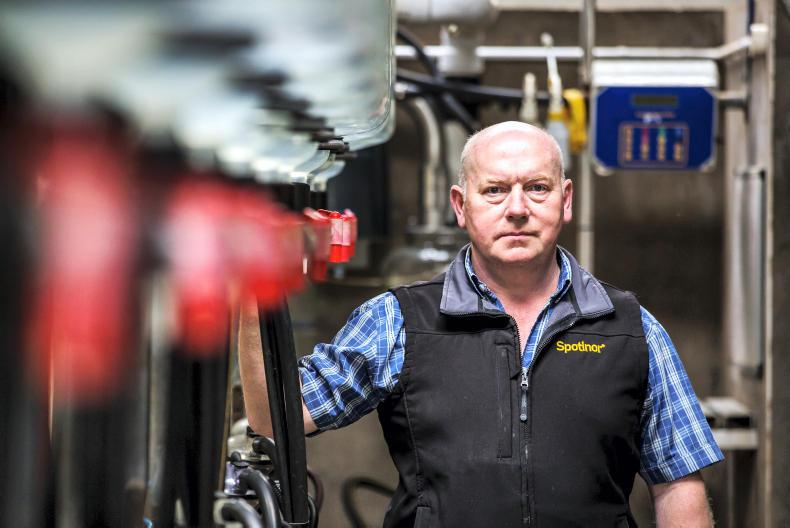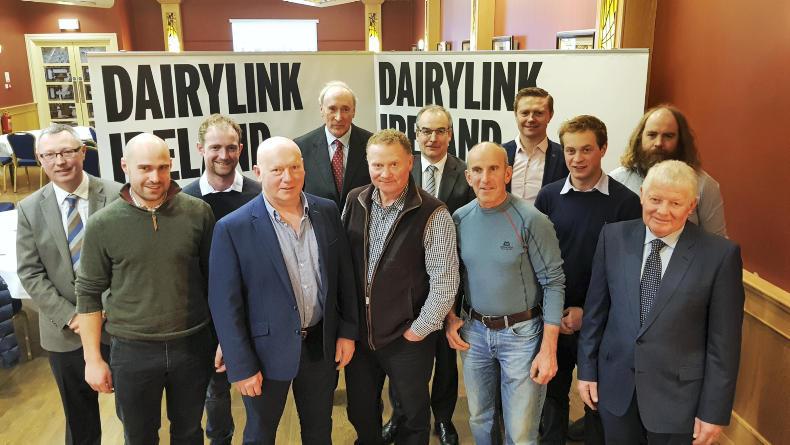Two questions were initially put to the new phase two farmers when they joined the Dairylink Ireland programme last year – what resources for milk production are available on your farm and what areas of dairy farming are you good at?
With Dairylink farmers operating different dairying systems across various land types and climatic conditions, a wide range of answers were given to programme adviser Conail Keown.
Identifying what resources are available on individual farms and what skills each farmer has helps form the basis of a plan for developing each farm business.
Investments made on farms aim to utilise available resources and are not about creating new ones
The main objective of Dairylink Ireland is to make best use of on-farm resources to optimise profit, so programme farmers need to take a critical look at their businesses to see what resources have untapped potential.
Investments made on farms aim to utilise available resources and are not about creating new ones.
For example, soils on most farms are not at optimum levels for pH, phosphorus and potassium. Addressing issues with soil fertility through use of lime, slurry and compound fertilisers will deliver increased grass growth.
Likewise, investing in grazing infrastructure, such as extra laneways, drinkers and fences, can allow cows to get to grass more often in the shoulders of the year and can allow more milk to be produced from grazed grass.
Skills
On the farmer skills question, it is about capitalising on what each farmer is good at and taking steps to make improvements where there is room to upskill. For example, more use of heat detection aids could be rolled out on farms if there are issues identifying heats in cows or heifers.
Conail Keown is working with several phase two Dairylink farmers to improve grazing management. Grazing blocks have been mapped and weekly grass measuring is taking place to help programme farmers improve their grassland management skills.
Improving herd genetics and cow type is a longer-term measure that will mainly be addressed through sire selection
At the official launch of Dairylink phase two in Armagh last week, Conail said that in the initial stage of the new farms joining the programme, plans have been developed and targets set for each farm business over the next three years.
“In the first six months, we have established what resources are available on your farms and found out what you are good at. It’s now time to take the steps to make your farm businesses more profitable and sustainable for the future,” he said.
Areas of focus on phase two Dairylink farms
There are several key areas where the focus will be for making improvements on Dairylink farms over phase two of the programme.
Improving herd genetics and cow type is a longer-term measure that will mainly be addressed through sire selection. In the shorter term, herd fertility could be addressed by better genetics, culling poor-fertility cows and making improvements with heat detection.
Fertility can also relate to animal health at both herd and individual cow levels. Herd health plans are being developed to prevent disease and are based on bulk tank milk screening and individual blood testing.
All farms will be soil sampled annually and fertiliser plans will be based on the results to address issues with soil fertility and manage nutrients. Grass measuring will be used to guide management decisions to improve grass quality.
Cash management is being monitored more closely by Dairylink farms and cashflow budgets for the next 12 months will be developed. Critical assessment of all farm expenditure is being carried out, with investment only targeted at high-return areas.
Other areas include labour management and environmental sustainability. “Dairying is under the spotlight now more than ever. It is important that farm businesses are sustainable environmentally and not just economically,” Conail said.

Farmer focus: Frank Goodman, Carrickmacross, Co MonaghanSoil fertility and grazing infrastructure is in a good place on Frank Goodman’s farm near Carrickmacross, Co Monaghan, and does not require significant amounts of investment over the next few years.
The 85-cow herd is split calving, with around 80% calving in the spring and the remaining 20% in the autumn. Cows are currently yielding 8,000 litres/cow at 3.76% butterfat and 3.30% protein. The grazing platform is heavily stocked at 4CE/ha and average concentrate feed rate stands at 2.5t/cow/year.

There are no pressing issues with grazing infrastructure on Frank's farm. \ Peter McCann
A series of targets for phase two of Dairylink have been set for Frank across the main themes of the programme. The aim is to grow 11.5t DM/ha of grass on the milking platform each year and generate a cash surplus of €300/cow.
In the past, cows that were slow to get in calf occasionally slipped between the two groups, but Frank wants anything with fertility issues to leave the herd in future. Improving herd fertility is a key aim on the Goodman farm and, for longer-term gains, sires will be selected based on fertility indices.
The Goodman herd is high quality, although there is room to lift butterfat and protein, so bulls will be selected for this.
Read more
Watch: getting ready for spring in Monaghan
Dairylink: starting the final round in Monaghan
Two questions were initially put to the new phase two farmers when they joined the Dairylink Ireland programme last year – what resources for milk production are available on your farm and what areas of dairy farming are you good at?
With Dairylink farmers operating different dairying systems across various land types and climatic conditions, a wide range of answers were given to programme adviser Conail Keown.
Identifying what resources are available on individual farms and what skills each farmer has helps form the basis of a plan for developing each farm business.
Investments made on farms aim to utilise available resources and are not about creating new ones
The main objective of Dairylink Ireland is to make best use of on-farm resources to optimise profit, so programme farmers need to take a critical look at their businesses to see what resources have untapped potential.
Investments made on farms aim to utilise available resources and are not about creating new ones.
For example, soils on most farms are not at optimum levels for pH, phosphorus and potassium. Addressing issues with soil fertility through use of lime, slurry and compound fertilisers will deliver increased grass growth.
Likewise, investing in grazing infrastructure, such as extra laneways, drinkers and fences, can allow cows to get to grass more often in the shoulders of the year and can allow more milk to be produced from grazed grass.
Skills
On the farmer skills question, it is about capitalising on what each farmer is good at and taking steps to make improvements where there is room to upskill. For example, more use of heat detection aids could be rolled out on farms if there are issues identifying heats in cows or heifers.
Conail Keown is working with several phase two Dairylink farmers to improve grazing management. Grazing blocks have been mapped and weekly grass measuring is taking place to help programme farmers improve their grassland management skills.
Improving herd genetics and cow type is a longer-term measure that will mainly be addressed through sire selection
At the official launch of Dairylink phase two in Armagh last week, Conail said that in the initial stage of the new farms joining the programme, plans have been developed and targets set for each farm business over the next three years.
“In the first six months, we have established what resources are available on your farms and found out what you are good at. It’s now time to take the steps to make your farm businesses more profitable and sustainable for the future,” he said.
Areas of focus on phase two Dairylink farms
There are several key areas where the focus will be for making improvements on Dairylink farms over phase two of the programme.
Improving herd genetics and cow type is a longer-term measure that will mainly be addressed through sire selection. In the shorter term, herd fertility could be addressed by better genetics, culling poor-fertility cows and making improvements with heat detection.
Fertility can also relate to animal health at both herd and individual cow levels. Herd health plans are being developed to prevent disease and are based on bulk tank milk screening and individual blood testing.
All farms will be soil sampled annually and fertiliser plans will be based on the results to address issues with soil fertility and manage nutrients. Grass measuring will be used to guide management decisions to improve grass quality.
Cash management is being monitored more closely by Dairylink farms and cashflow budgets for the next 12 months will be developed. Critical assessment of all farm expenditure is being carried out, with investment only targeted at high-return areas.
Other areas include labour management and environmental sustainability. “Dairying is under the spotlight now more than ever. It is important that farm businesses are sustainable environmentally and not just economically,” Conail said.

Farmer focus: Frank Goodman, Carrickmacross, Co MonaghanSoil fertility and grazing infrastructure is in a good place on Frank Goodman’s farm near Carrickmacross, Co Monaghan, and does not require significant amounts of investment over the next few years.
The 85-cow herd is split calving, with around 80% calving in the spring and the remaining 20% in the autumn. Cows are currently yielding 8,000 litres/cow at 3.76% butterfat and 3.30% protein. The grazing platform is heavily stocked at 4CE/ha and average concentrate feed rate stands at 2.5t/cow/year.

There are no pressing issues with grazing infrastructure on Frank's farm. \ Peter McCann
A series of targets for phase two of Dairylink have been set for Frank across the main themes of the programme. The aim is to grow 11.5t DM/ha of grass on the milking platform each year and generate a cash surplus of €300/cow.
In the past, cows that were slow to get in calf occasionally slipped between the two groups, but Frank wants anything with fertility issues to leave the herd in future. Improving herd fertility is a key aim on the Goodman farm and, for longer-term gains, sires will be selected based on fertility indices.
The Goodman herd is high quality, although there is room to lift butterfat and protein, so bulls will be selected for this.
Read more
Watch: getting ready for spring in Monaghan
Dairylink: starting the final round in Monaghan








 This is a subscriber-only article
This is a subscriber-only article









SHARING OPTIONS: